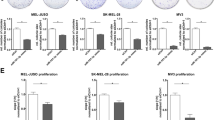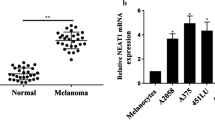Abstract
Although several studies have shown a dysregulation of microRNA (miRNA) expression profiles in cutaneous melanoma, there has been little research on the miRNA machinery itself. In this study, we investigated the mRNA expression profiles of different miRNA machinery components in primary cutaneous malignant melanoma (PCMM), cutaneous malignant melanoma metastases (CMMM) and benign melanocytic nevi (BMN). Patients with PCMM (n = 7), CMMM (n = 6) and BMN (n = 7) were included in the study. Punch biopsies were harvested from the centers of tumors (lesional) and from BMN (control). In contrast to previous reports exploring specific clusters of miRNAs in PCMM, the present study investigates mRNA expression levels of Dicer, Drosha, Exp5, DGCR8 and the RISC components PACT, argonaute-1, argonaute-2, TARBP1, TARBP2, MTDH and SND1, which were detected by TaqMan real-time reverse transcription polymerase chain reaction (RT-PCR). Argonaute-1, TARBP2 and SND1 expression levels were significantly higher in BMN compared to PCMM (p < 0.05). TARBP2 expression levels were significantly higher in CMMM compared to PCMM (p < 0.05). SND1 expression levels were significantly higher in CMMM compared to PCMM and BMN (p < 0.05). Dicer, Drosha, DGCR8, Exp5, argonaute-2, PACT, TARBP1 and MTDH expression levels showed no significant differences within groups (p > 0.05). The results of this study show that the miRNA machinery components argonaute-1, TARBP2 and SND1 are dysregulated in PCMM and CMMM compared to BMN and may play a role in the process of malignant transformation.

Similar content being viewed by others
References
Bartel DP (2004) MicroRNAs: genomics, biogenesis, mechanism, and function. Cell 116:281–297
Bonazzi VF, Stark MS, Hayward NK (2011) MicroRNA regulation of melanoma progression. Melanoma Res (in press)
Caudy AA, Ketting RF, Hammond SM, Denli AM, Bathoorn AM, Tops BB, Silva JM, Myers MM, Hannon GJ, Plasterk RH (2003) A micrococcal nuclease homologue in RNAi effector complexes. Nature 425:411–414
Dalmay T (2008) Identification of genes targeted by microRNAs. Biochem Soc Trans 36:1194–1196
de Kok JB, Roelofs RW, Giesendorf BA, Pennings JL, Waas ET, Feuth T, Swinkels DW, Span PN (2005) Normalization of gene expression measurements in tumor tissues: comparison of 13 endogenous control genes. Lab Invest 85:154–159
Emdad L, Sarkar D, Su ZZ, Randolph A, Boukerche H, Valerie K, Fisher PB (2006) Activation of the nuclear factor kappaB pathway by astrocyte elevated gene-1: implications for tumor progression and metastasis. Cancer Res 66:1509–1516
Faehnle CR, Joshua-Tor L (2007) Argonautes confront new small RNAs. Curr Opin Chem Biol 11:569–577
Fleige S, Pfaffl MW (2006) RNA integrity and the effect on the real-time qRT-PCR performance. Mol Asp Med 27:126–139
Friedman RC, Farh KK, Burge CB, Bartel DP (2009) Most mammalian mRNAs are conserved targets of microRNAs. Genome Res 19:92–105
Gartel AL, Kandel ES (2006) RNA interference in cancer. Biomol Eng 23:17–34
Glud M, Manfe V, Biskup E, Holst L, Dirksen AM, Hastrup N, Nielsen FC, Drzewiecki KT, Gniadecki R (2011) MicroRNA miR-125b induces senescence in human melanoma cells. Melanoma Res 21:253–256
Gregory RI, Chendrimada TP, Cooch N, Shiekhattar R (2005) Human RISC couples microRNA biogenesis and posttranscriptional gene silencing. Cell 123:631–640
Gregory RI, Yan KP, Amuthan G, Chendrimada T, Doratotaj B, Cooch N, Shiekhattar R (2004) The Microprocessor complex mediates the genesis of microRNAs. Nature 432:235–240
Han J, Lee Y, Yeom KH, Kim YK, Jin H, Kim VN (2004) The Drosha-DGCR8 complex in primary microRNA processing. Genes Dev 18:3016–3027
Holst LM, Kaczkowski B, Gniadecki R (2010) Reproducible pattern of microRNA in normal human skin. Exp Dermatol 19:e201–205
Howell PM Jr, Li X, Riker AI, Xi Y (2010) MicroRNA in Melanoma. Ochsner J 10:83–92
Kim BC, Seung NR, Park EJ, Kwon IH, Kim KH, Kim KJ, Park HR (2011) Immunohistochemical study of the expression of astrocyte elevated gene-1 (AEG-1) in malignant melanoma, spitz nevus and dysplastic nevus. Korean J Dermatol 49:334–338
Kim VN (2004) MicroRNA precursors in motion: exportin-5 mediates their nuclear export. Trends Cell Biol 14:156–159
Landthaler M, Yalcin A, Tuschl T (2004) The human DiGeorge syndrome critical region gene 8 and Its D. melanogaster homolog are required for miRNA biogenesis. Curr Biol 14:2162–2167
Lee Y, Hur I, Park SY, Kim YK, Suh MR, Kim VN (2006) The role of PACT in the RNA silencing pathway. EMBO J 25:522–532
Lee Y, Jeon K, Lee JT, Kim S, Kim VN (2002) MicroRNA maturation: stepwise processing and subcellular localization. EMBO J 21:4663–4670
Lewis BP, Burge CB, Bartel DP (2005) Conserved seed pairing, often flanked by adenosines, indicates that thousands of human genes are microRNA targets. Cell 120:15–20
Li CL, Yang WZ, Chen YP, Yuan HS (2008) Structural and functional insights into human Tudor-SN, a key component linking RNA interference and editing. Nucleic Acids Res 36:3579–3589
Ma Z, Swede H, Cassarino D, Fleming E, Fire A, Dadras SS (2011) Up-regulated Dicer expression in patients with cutaneous melanoma. PLoS One 6:e20494
Mueller DW, Rehli M, Bosserhoff AK (2009) miRNA expression profiling in melanocytes and melanoma cell lines reveals miRNAs associated with formation and progression of malignant melanoma. J Invest Dermatol 129:1740–1751
Reinhart BJ, Slack FJ, Basson M, Pasquinelli AE, Bettinger JC, Rougvie AE, Horvitz HR, Ruvkun G (2000) The 21-nucleotide let-7 RNA regulates developmental timing in Caenorhabditis elegans. Nature 403:901–906
Riker AI, Enkemann SA, Fodstad O, Liu S, Ren S, Morris C, Xi Y, Howell P, Metge B, Samant RS, Shevde LA, Li W, Eschrich S, Daud A, Ju J, Matta J (2008) The gene expression profiles of primary and metastatic melanoma yields a transition point of tumor progression and metastasis. BMC Med Genomics 1:13
Sand M, Gambichler T, Sand D, Altmeyer P, Stuecker M, Bechara FG (2011a) Immunohistochemical expression patterns of the microRNA-processing enzyme Dicer in cutaneous malignant melanomas, benign melanocytic nevi and dysplastic melanocytic nevi. Eur J Dermatol 21:18–21
Sand M, Gambichler T, Sand D, Skrygan M, Altmeyer P, Bechara FG (2009) MicroRNAs and the skin: tiny players in the body’s largest organ. J Dermatol Sci 53:169–175
Sand M, Gambichler T, Skrygan M, Sand D, Scola N, Altmeyer P, Bechara FG (2010) Expression levels of the microRNA processing enzymes Drosha and dicer in epithelial skin cancer. Cancer Invest 28:649–653
Sand M, Skrygan M, Georgas D, Arenz C, Gambichler T, Sand D, Altmeyer P, Bechara FG (2011b) Expression levels of the microRNA maturing microprocessor complex component DGCR8 and the RNA-induced silencing complex (RISC) components Argonaute-1, Argonaute-2, PACT, TARBP1, and TARBP2 in epithelial skin cancer. Mol Carcinog (in press)
Scatolini M, Grand MM, Grosso E, Venesio T, Pisacane A, Balsamo A, Sirovich R, Risio M, Chiorino G (2010) Altered molecular pathways in melanocytic lesions. Int J Cancer 126:1869–1881
Yoo BK, Santhekadur PK, Gredler R, Chen D, Emdad L, Bhutia S, Pannell L, Fisher PB, Sarkar D (2011) Increased RNA-induced silencing complex (RISC) activity contributes to hepatocellular carcinoma. Hepatology 53:1538–1548
Zhang JD, Biczok R, Ruschhaupt M (2011) http://www.bioconductor.org/packages/bioc/html/ddCt.html.
Acknowledgments
This work was generously supported in part by Fleur-Hiege-Stiftung-gegen-Hautkrebs, Hamburg, Germany. The authors are grateful to Dr. Cornelia Graf and Stefan Kotschote, M.S., for technical assistance.
Financial disclosure
All authors hereby disclose any commercial associations that may pose or create a conflict of interest with the information presented in this manuscript. The authors report no conflicts of interest. The authors alone are responsible for the content and writing of the paper.
Conflict of interest
We declare that we have no conflict of interest.
Author information
Authors and Affiliations
Corresponding author
Rights and permissions
About this article
Cite this article
Sand, M., Skrygan, M., Georgas, D. et al. The miRNA machinery in primary cutaneous malignant melanoma, cutaneous malignant melanoma metastases and benign melanocytic nevi. Cell Tissue Res 350, 119–126 (2012). https://doi.org/10.1007/s00441-012-1446-0
Received:
Accepted:
Published:
Issue Date:
DOI: https://doi.org/10.1007/s00441-012-1446-0




